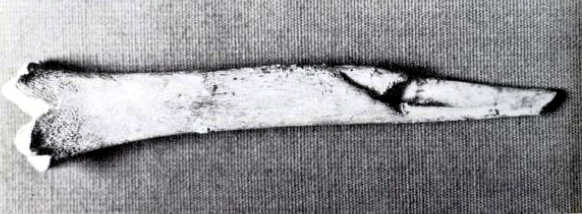The majority of writers maintain that by the beginning of the Pleistocene epoch one million years ago, humans took an important step forward - they started making their own tools.
"Miocene and early Pliocene ancestors may have been tool users without having reached the stage of systematic tool-making," writes K. P. Oakley, in his book Man the Tool-maker. In his opinion, by the beginning of the Pleistocene, man was making his own tools.
My contention is that humans did not make their own tools before they reached the stage of Homo sapiens, before they were capable of abstract thoughts. There is no positive evidence that any of the tools exhibited in various museums and attributed to the period before Homo sapiens is a man-made instrument. All objects shown in museums or reproduced in books as artefacts of humans, could have been molded by the elements, objects that could be found shaped by nature today.
The so-called "hand-axes," which would have brought mankind to the so-called period of "hand-ax culture" could have been found at any time near any rocks. Similar sharp objects must have been picked up and used even by the apes, as they do today when they need them.
It is logical that the stone objects attributed to human manufacture before the appearance of Homo sapiens cannot have been made by humans. It is logical because in order to make a tool one needs a tool-making machine or instrument. In order to have a tool-making instrument one needs a developed brain, a brain capable of abstract thoughts. Men could not have imitated other animals in making tools or tool-making instruments, as even today there is no such animal. However conceited humanity may be, we have no positive evidence of any abstract thought before Homo sapiens. Only with the appearance of Homo sapiens can we add to perceptual thinking, which other animals are also capable of, that peculiarity of humans, abstract thinking. Tool-making or weapon-making presupposes holding tools and carrying weapons. This, apart from being an encumbrance to the still precarious upright posture of humans would have contradicted the nature of an opportunist. It may be said that the only pattern of behavior in the life of an opportunist is improvisation, improvisation inspired by the particular objective circumstances at a given moment. An improviser never carries tools or weapons, for he never knows what the next situation may be. He gathers his tools and his weapons on the spot, his choice depending on the exigencies of the situation. Carrying tools and weapons presupposes premeditation, which, being abstract thinking, cannot have started before the appearance of Homo sapiens. Before Homo sapiens, humans were not, surely, tool-makers, but tool-gatherers. Humans were using stones, bones, and sticks as tools or weapons, all of which were available for immediate use.
An ape, even today, uses a fallen branch as a tool or weapon, but would never deliberately, even if circumstances demanded it, return to the tree to break off a branch and make it into a stick. This would be a creative mental operation which apes of today and humans of yesterday were incapable of doing.

Disclaimer - Copyright - Contact
Online: buildfreedom.org | terrorcrat.com / terroristbureaucrat.com